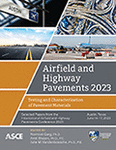Initial Investigation of Using Waste Rubber Tires as a Sustainable Material for the Development of Electrically Conductive Rigid Pavements
Publication: Airfield and Highway Pavements 2023
ABSTRACT
The accumulation of snow on roadway surfaces has the potential to result in deadly accidents and financial damage. Heated pavement systems (HPS) have gained popularity in recent years as a way of mitigating the snow accumulation on rigid pavements. While these approaches seem promising, they are also costly due to the raw resources used, which accelerates the depletion of these raw materials. This research aims to present a sustainable approach for de-icing the accumulated snow on rigid pavements. The method depends on using waste rubber tires as the source of heating to be applied to the rigid pavements. Depending on the mesh of steel wires embedded inside the rubber tires. It has been noticed that passing current through these steel wires embedded inside the rubber can produce heat. The outcomes of the investigation validate the effectiveness of the suggested method of heating the pavement and melting the snow.
Get full access to this article
View all available purchase options and get full access to this chapter.
REFERENCES
A. Yehia, and C. Y. Tua. Thin Conductive Concrete Overlay for Bridge Deck Deicing and Anti-Icing Sherif.
J. Wu, J. Liu, and F. Yang. “Three-phase composite conductive concrete for pavement deicing,” Constr Build Mater, vol. 75, pp. 129–135, Jan. 2015, doi: https://doi.org/10.1016/j.conbuildmat.2014.11.004.
W. A. Nixon and Strategic Highway Research Program (US). Improved cutting edges for ice removal. Strategic Highway Research Program, National Research Council, 1993.
H. Ceylan, K. Gopalakrishnan, S. Kim, W. Cord, and A. Uk. Civil, Construction and Environmental Engineering Conference Presentations and Proceedings, 2014. [Online]. Available: http://lib.dr.iastate.edu/ccee_conf/23.
A. Arabzadeh, et al. Influence of Deicing Salts on the Water-Repellency of Portland Cement Concrete Coated with Polytetrafluoroethylene and Polyetheretherketone.
A. Jamil, S. Riaz, M. Ashraf, and M. R. Foolad. “Gene expression profiling of plants under salt stress,” Critical Reviews in Plant Sciences, vol. 30, no. 5. pp. 435–458, Sep. 2011. doi: https://doi.org/10.1080/07352689.2011.605739.
S. Guo, R. Si, Q. Dai, Z. You, Y. Ma, and J. Wang. “A critical review of corrosion development and rust removal techniques on the structural/environmental performance of corroded steel bridges,” Journal of Cleaner Production, vol. 233. Elsevier Ltd, pp. 126–146, Oct. 01, 2019. doi: https://doi.org/10.1016/j.jclepro.2019.06.023.
A. Arabzadeh, H. Ceylan, S. Kim, K. Gopalakrishnan, and A. Sassani. “Superhydrophobic coatings on asphalt concrete surfaces: Toward smart solutions for winter pavement maintenance,” Transp Res Rec, vol. 2551, pp. 10–17, 2016, doi: https://doi.org/10.3141/2551-02.
A. Arabzadeh, H. Ceylan, S. Kim, K. Gopalakrishnan, and A. Sassani. Fabrication of Polytetrafluoroethylene-Coated Asphalt Concrete Biomimetic Surfaces: A Nanomaterials-Based Pavement Winter Maintenance Approach, 2016.
H. Ceylan, A. Arabzadeh, A. Sassani, S. Kim, and K. Gopalakrishnan. Innovative Nano-engineered Asphalt Concrete for Ice and Snow Controls in Pavement Systems, Jan. 2017. doi: https://doi.org/10.14311/ee.2016.388.
A. Arabzadeh, et al. “Superhydrophobic coatings on Portland cement concrete surfaces,” Constr Build Mater, vol. 141, pp. 393–401, Jun. 2017, doi: https://doi.org/10.1016/j.conbuildmat.2017.03.012.
Y. Lai, Y. Liu, and D. Ma. “Automatically melting snow on airport cement concrete pavement with carbon fiber grille,” Cold Reg Sci Technol, vol. 103, pp. 57–62, 2014, doi: https://doi.org/10.1016/j.coldregions.2014.03.008.
C. Chang, M. Ho, G. Song, Y. L. Mo, and H. Li. “A feasibility study of self-heating concrete utilizing carbon nanofiber heating elements,” Smart Mater Struct, vol. 18, no. 12, 2009, doi: https://doi.org/10.1088/0964-1726/18/12/127001.
H. Ceylan, et al. Self-Heating Electrically Conductive Concrete Demonstration Project tech transfer summary Self-Heating Electrically Conductive Concrete Demonstration Project PRINCIPAL INVESTIGATOR CO-PRINCIPAL INVESTIGATORS Objective and Goals, 2021.
J. Gomis, O. Galao, V. Gomis, E. Zornoza, and P. Garcés. “Self-heating and deicing conductive cement. Experimental study and modeling,” Constr Build Mater, vol. 75, pp. 442–449, May 2015, doi: https://doi.org/10.1016/j.conbuildmat.2014.11.042.
C. Y. Tuan. “Implementation of Conductive Concrete for Deicing (Roca Bridge),” 2008. [Online]. Available: https://digitalcommons.unl.edu/ndor.
H. Xu, D. Wang, Y. Tan, J. Zhou, and M. Oeser. “Investigation of design alternatives for hydronic snow melting pavement systems in China,” J Clean Prod, vol. 170, pp. 1413–1422, Jan. 2018, doi: https://doi.org/10.1016/j.jclepro.2017.09.262.
H. Wang, L. Liu, and Z. Chen. “Experimental investigation of hydronic snow melting process on the inclined pavement,” Cold Reg Sci Technol, vol. 63, no. 1–2, pp. 44–49, Aug. 2010, doi: https://doi.org/10.1016/j.coldregions.2010.04.007.
P. Pan, S. Wu, Y. Xiao, and G. Liu. “A review on hydronic asphalt pavement for energy harvesting and snow melting,” Renewable and Sustainable Energy Reviews, vol. 48. Elsevier Ltd, pp. 624–634, Aug. 01, 2015. doi: https://doi.org/10.1016/j.rser.2015.04.029.
Information & Authors
Information
Published In
History
Published online: Jun 13, 2023
ASCE Technical Topics:
- Business management
- Climates
- Concrete pavements
- Engineering fundamentals
- Engineering materials (by type)
- Environmental engineering
- Infrastructure
- Materials engineering
- Measurement (by type)
- Meteorology
- Pavements
- Practice and Profession
- Precipitation
- Recycling
- Snow
- Sustainable development
- Temperature effects
- Temperature measurement
- Tire recycling
- Traffic accidents
- Traffic engineering
- Traffic management
- Transportation engineering
- Vehicle-pavement interaction
Authors
Metrics & Citations
Metrics
Citations
Download citation
If you have the appropriate software installed, you can download article citation data to the citation manager of your choice. Simply select your manager software from the list below and click Download.
